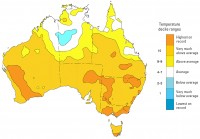Bureau publishes definitive report on Australia?s climate in 2014
10/02/2015

The Bureau of Meteorology has published its Annual Climate Report 2014, the comprehensive accompaniment to its Annual Climate Statement issued on 6 January 2015.
Both the Annual Climate Report and Statement confirm Australia recorded its third warmest calendar year in 2014 since national temperature records began in 1910.
Assistant Director for Climate Information Services, Neil Plummer, said 2014 was characterised by frequent heatwaves and warm spells, and a notable reduction in cold weather.
“Much of Australia experienced temperatures very much above average in 2014, with mean temperatures 0.91°C above the long-term average,” said Mr Plummer.
“This follows the warmest year on record in 2013, which was 1.20°C warmer than average.
“Particularly warm conditions occurred in spring 2014, which was Australia’s warmest spring on record.
“El Niño-like effects were felt in drier and warmer conditions in much of eastern Australia during 2014.”
Other climate facts and events of significance in 2014 include:
For Australia as a whole, rainfall was slightly above average for the year, with 483.5mm (1961–1990 average 465mm).
Prolonged rainfall deficiencies continued for inland and southeastern Queensland and northeastern New South Wales.
Six significant heatwaves and warm spells occurred, including one of southeast Australia’s most prolonged heatwaves in mid-January.
A number of major bushfires occurred during January and February, with particularly destructive fires in Victoria and South Australia.
Four tropical cyclones made landfall during 2014, with tropical cyclone Ita the most intense; crossing the coast near Cooktown as a category 4 system, bringing rainfall totals in excess of 300mm.
A stormy spring, with severe thunderstorms striking Brisbane in late November, causing flash flooding, very large hailstones and destructive winds.
An East Coast Low off the central and southern New South Wales coast in August caused storm damage and brought more than 100mm of rain to some parts of the coast.
Sea surface temperatures around Australia were unusually warm with 2014 the equal-third-warmest year on record at 0.51°C above average.
Nationally, Australian temperatures have warmed approximately one degree since 1950, and the continued warmth in 2014 adds to this long-term warming trend.
Globally, the World Meteorological Organization ranked 2014 as the warmest year on record.
To download the Annual Climate Report 2014 go to www.bom.gov.au/climate/annual_sum/2014/ or visit our Newsroom media.bom.gov.au/ to watch or share the video.










